 |
|
|
| (Information by Peter Kessler and Edward Dawson, with additional information from The Horse, the Wheel, and Language: How Bronze-Age Riders from the Eurasian Steppes Shaped the Modern World, David W Anthony, from The Iliad, Homer (Translated by E V Rieu, Penguin Books, 1963), from Europe Before History, Kristian Kristiansen, from A Dictionary of Greek and Roman Biography and Mythology, William Smith (Ed), from An Historical Geography of Europe, Norman J G Pounds (Abridged Version), from History of Humanity - Scientific and Cultural Development: From the Third Millennium to the Seventh Century BC (Vol II), Ahmad Hasan Dani, Jean-Pierre Mohen, J L Lorenzo, & V M Masson (Unesco 1996), and from External Links: The Greeks really do have near-mythical origins, ancient DNA reveals (Science), and Phthia (DBpedia).) |
|
|
| fl c.1270s? BC |
Hellen |
King of Thessaly. Namesake of the Hellenes. |
Homer in The Iliad notes the Hellenes in his 'Catalogue of Ships'. He refers to them as a small small tribe in Thessalic Phthia who are under the command of Achilles. Thucydides states that, prior to Hellen, the name 'Hellas' does not exist. 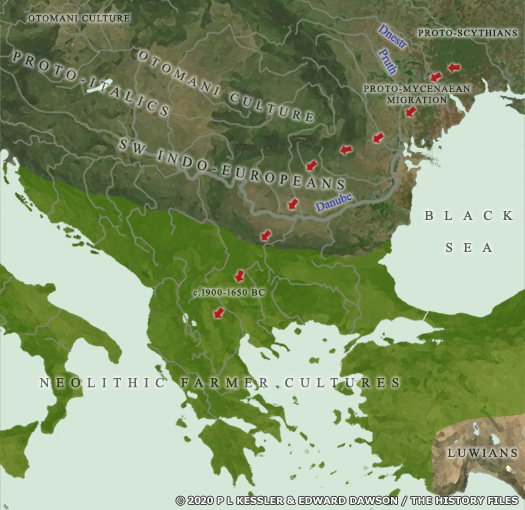 The proto-Mycenaeans seem to have been amongst the last of the western Indo-European _centum_-speakers to take to the road, following a path which had been trodden by related tribes for the past thousand years (click or tap on map to view full sized) The proto-Mycenaeans seem to have been amongst the last of the western Indo-European _centum_-speakers to take to the road, following a path which had been trodden by related tribes for the past thousand years (click or tap on map to view full sized) |
|
|
| Instead various tribes occupy the area under various names, notably 'Pelasgian'. This changes as Hellen and his sons 'grew strong in Phthiotis', allying with various cities in war. One by one these cities become more closely associated with Hellen and his sons (ie. they become increasingly infused with early Mycenaean culture and domination) and come to be referred to as 'Hellenes'. Eventually the name is applied to all Greeks. |
|
|
| fl c.1260s? BC |
Doros / Dorus |
Son. |
| fl c.1260s? BC |
Xouthos / Xuthus |
Brother. First of the Aeolides. Progenitor of the Greek nation. |
Xouthos is noted as a prince of Phthia and progenitor of the Aeolides line. He becomes ruler of the Peloponnesus and is the originator of the Achaean (Mycenaean) and Ionian people, the latter of whom survive the fall of Mycenaean civilisation in Athens. 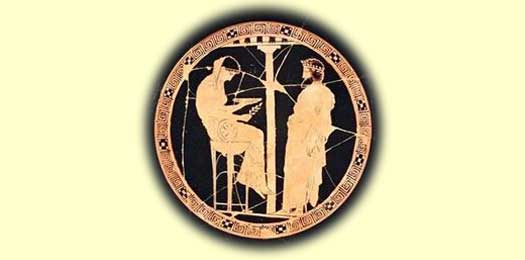 Aegeus, grandson of the semi-mythical King Erichthonius of Athens, consults the Oracle at Delphi for advice regarding his lack of a male heir despite two marriages Aegeus, grandson of the semi-mythical King Erichthonius of Athens, consults the Oracle at Delphi for advice regarding his lack of a male heir despite two marriages |
|
|
| fl c.1250s? BC |
Achaeos / Aiakos |
Son. Not the grandfather of Achilles. |
| Succeeding Hellen and his line, Myrmidon is the son of Zeus and Eurymedousa, the 'wide-ruling' princess of Phthia (therefore meaning that Greek oral history has lost the name of his earthly father). Eurymedousa is the daughter of Achelous or Cletor. The first of those is a pre-Greek name, possibly Pelasgian, tentatively suggesting again (after the actions of Hellen himself) an element of late Mycenaean settlement in the region. |
|
|
| fl c.1240s? BC |
Myrmidon |
First of the Myrmidones line. |
Greek myths surrounding Myrmidon and his immediate successors suggest a merging of two families or clans. Myrmidon's son is Actor. Depending on the specific story, he either dies childless or is the father of Eurytion. This king of Phthia would seem to rule around the same time as Aeacus 'founds' Phthia (or more likely rebuilds it, or establishes a new kingship). 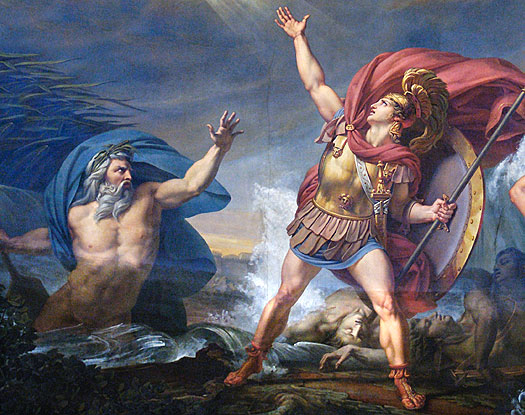 On the left is the river god, Scamandrus, mythical ancestor of Teucer of the Troad, fighting against the Mycenaean hero, Achilles On the left is the river god, Scamandrus, mythical ancestor of Teucer of the Troad, fighting against the Mycenaean hero, Achilles |
|
|
| fl c.1230s? BC |
Actor |
Son. Died childress, or father of Eurytion. |
| fl c.1210s? BC |
Echecles / Aeacus |
King of Aegina (Saronic Islands). Founder of Phthia. |
| fl c.1210s? BC |
Eurytion |
Son of Actor? Co-ruler? |
| Pileas is said to originate from Magnesia, which borders Phthia on the western side of Mount Othrys. The same homeland is ascribed to Jason of Iolkos, leader of the Argonauts. This Pileas is not the same as the Pelias who robs Jason of his throne, but is instead the founder of the Pileides, who provide not only the subsequent kings of Phthia, but who are also claimed as the ancestors of the kings of classical Epirus. |
|
|
| fl c.1200 BC |
Pileas / Peleus |
Son of Aeacus. First of the Pileides line. |
| c.1200 BC |
The Dorian invasion of Greece from the north takes place between about 1200-1140 BC, with the Mycenaean city states to the north falling between those dates, and with domination being achieved by about 1140 BC. 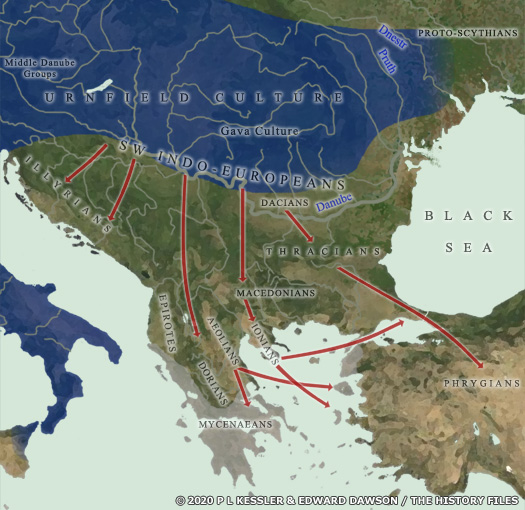 Climate-induced drought in the thirteenth century BC created great instability in the entire eastern Mediterranean region, resulting in mass migration in the Balkans, as well as the fall of city states and kingdoms further east (click or tap on map to view full sized) Climate-induced drought in the thirteenth century BC created great instability in the entire eastern Mediterranean region, resulting in mass migration in the Balkans, as well as the fall of city states and kingdoms further east (click or tap on map to view full sized) |
|
All Mycenaean palaces and fortified sites are destroyed and a major proportion of other sites are abandoned. The population of the Peloponnese appears to decline by about seventy-five percent. The city of Mycenae itself remains occupied, but is burned twice in succession and survives in a much-reduced state and size, never again to hold the reins of power. Once the Hittites had been destroyed around 1200 BC, and the Mycenaeans had themselves (probably) smashed Troy, the colonisation of the western coast of Anatolia could begin (the possibility that the earlier Ahhiyawa may also be a Mycenaean colony notwithstanding). This would seem to be the most likely - and popular - avenue of Mycenaean escape from the mainland, albeit not for the nobility of Phthia who chose a different direction. However, in common with much of the Near East, this general instability which has been driven by a major regional drought causes a dark age to fall throughout the remainder of Greece, until about 750 BC, when early Classical Greece begins to emerge. 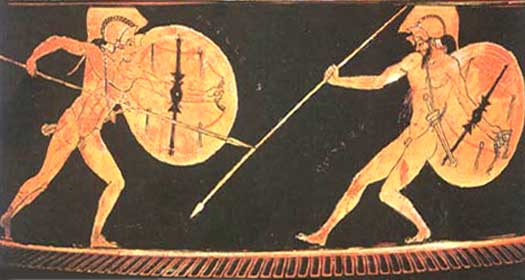 Greek pottery often displayed famous battle scenes, such as this one in which Achilles fights against Hector, son of Priam, just before the latter is killed Greek pottery often displayed famous battle scenes, such as this one in which Achilles fights against Hector, son of Priam, just before the latter is killed |
|
|
| ? - c.1183 BC |
Achilles |
Son. Took part in the war against Troy. |
| c.1193 - 1183 BC |
Achilles leads his fierce Myrmidones (Myrmidons) in the Mycenaean forces which attack Troy. Uncertain of where to make landfall, the fleet comes ashore in Mysia at the start of the campaign and is attacked by Telephas, ruler of Mysia, an ally of Troy. Achilles strikes back against his attackers and wounds the king. When the Greeks help to heal the king's wound, he points them towards Troy. Achilles is also responsible for sacking the Leleges city of Pedasus. At Troy itself, Achilles swiftly kills Cygnus of Kolonae, Mynes of Lyrnessos, and Hector, son of Priam, but is subsequently killed by Paris. |
|
| fl c.1183 BC |
Neoptolemus |
Son. Killed Priam of Troy and Eurypylos of Mysia. |
| c.1183 BC |
The Greek myths and stories about Phthia end with Neoptolemus and his reign as king. The living sources of the kingdom's oral history (mythical or otherwise) are overthrown throughout much of Mycenaean Greece by the invading Dorians. 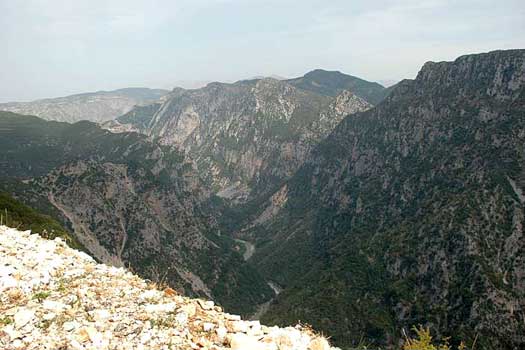 The mountainous landscape of all but coastal Epirus required a hardy inhabitant, and the region's remoteness may have had a bearing on its poorly recorded history in the ancient world The mountainous landscape of all but coastal Epirus required a hardy inhabitant, and the region's remoteness may have had a bearing on its poorly recorded history in the ancient world |
|
| Greece enters a dark age. Following the Trojan War, Neoptolemus himself settles his contingent of Mycenaean Greeks in Epirus, where he founds a kingdom and his successors survive the Doric invasion. During the rise of Classical Greece Phthia re-emerges as a minor city. |
|
|
|
|
|
| Phthia (Greeks) A former Mycenaean city state, Phthia re-emerged following the Greek Dark Age as a Thessalonian subject region. It had a capital in the town of Pharsalos in which three families governed in the form of the Daochides, Echekratides, and Menonides. During this period it was more usually known as Achaean Phthiotis. Unfortunately, even by the usual standards for this period, there seems to be very little on Phthia and its place in Classical Greece, suggesting that it was a minor state of little importance, perhaps a sub-kingdom of Thessaly. Plato refers to Phthia in Crito, where the imprisoned Socrates mentions 'fertile Phthia'. This is a conscious repetition of Homer's use of the same expression in The Iliad, when Achilles threatened to return home in the face of Agamemnon usurping his war prize. |
|
|
 |
|
|
|
|
|
| fl c.530 BC |
Echecratidas I |
Of the Echecratides of Thessaly. King of Thessaly. |
| fl c.525 BC |
Menon I |
Of the Menonides. |
| fl c.515 BC |
Andiochos |
Of Thessaly. King of Thessaly. |
| fl c.480 BC |
Acnonios |
Of the Daochides. |
| ? 476 BC |
Menon II |
Of the Menonides. |
| 476 - 460 BC |
Echecratidas II |
Of the Echecratides. King of Thessaly. |
| 460 - 454 BC |
Orestes |
Son. King of Thessaly. |
| 454/453 BC |
An [ Athenian](GreeceAthensGreeks.htm#Elected Archons Classical) army under the command of Myronides marches into Thessaly, being joined by allied Boeotians and Phocians along the way. The campaign is partly in revenge for losses suffered in a previous campaign, but also by a wish to restore Orestes to his native city. Orestes' late father had been an Athenian ally. The campaign ends without a result, and the Athenians return home along with Orestes. It seems that many of the former noble families of Thessaly have been subject to heavy losses in the past half a century, and Thessalian kingship suffers as a result. 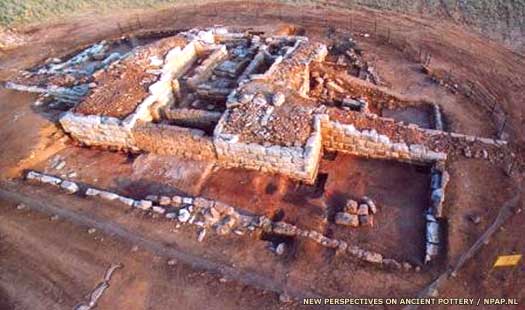 The town of Halos, near modern Almyros on the western side of the Pagasitic Gulf, fell within Achaean Phthiotis and was occupied from the early tenth century BC onwards The town of Halos, near modern Almyros on the western side of the Pagasitic Gulf, fell within Achaean Phthiotis and was occupied from the early tenth century BC onwards |
|
| 454 - 432 BC |
Menon III |
Of the Menonides. |
| c.440s BC |
'Some years' after the expedition by Myronides, Pericles of[Athens](GreeceAthensGreeks.htm#Elected Archons Classical) summons a conference of all the Greeks to confer about the shrines destroyed by the Persians during the invasion of 480-479 BC. Among those invited to attend are the Thessalians, the Phthiot Achaeans (one of the few direct mentions of Phthia itself), the Oetaeans and the Malians. However, opposition bySparta causes the project to be abandoned. |
|
| 432 - 405 BC |
Daochos I / Daochus I |
Of the Daochides of Thessaly. King of Thessaly. |
| 405 - ? BC |
Menon IV |
Of the Menonides. |
| ? - c.380 BC |
Sisyphus I |
Of the Daochides. |
| fl c.380 - 370 BC |
Polydamas |
|
| fl c.360s BC |
Menon V |
Of the Menonides. |
| fl c.361 BC |
Agelaos / Agelas |
Of Thessaly. King of Thessaly. |
| 346 - 339 BC |
Cottyphus |
|
| fl c.339 - 338 BC |
Daochos II / Daochus II |
Of the Daochides. |
| 338 - 337 BC |
Philip II of Macedonia defeats the Greek states at the Battle of Chaeronea and gains overlordship over all of Greece, including[Athens](GreeceAthensGreeks.htm#Elected Archons Classical), Corinth and Sparta. Athens and other city states join the Corinthian League (or Hellenic League) which is formed by Phillip to unify the military forces at his command so that he can pressure Persia. |
|
| 338 - c.330? BC |
Sisyphus II |
Of the Daochides. |
| c.330 - 229 BC |
Phthia is conquered by[Macedonia](GreeceMacedonia.htm#Great Kings), although there seems to be no explanation regarding why it had not been included in the list of conquests of 337 BC. |
|
| 229 - 217 BC |
Phthia is part of the Aetolian League from 229 BC. The details regarding its withdrawal from Macedonian control are unknown, but in the same year, Demetrius of Macedonia dies shortly after a disastrous battle against the Dardanii on the kingdom's northern border. His son, Philip, is an infant, so his cousin is offered the throne as his guardian. He rescues the kingdom from collapse, and defeats the Dardanii, but perhaps Phthia takes the opportunity to leave Macedonian protection. Instead, the Aetolian League is a confederation of Greek cities that has been established to oppose Macedonia. It consists of territory on the southern borders of Epirus and Macedonia, with the Achaean League to its east and south, on the Peloponnese. |
|
| 217 - 168 BC |
Phthia is re-conquered by Macedonia. Following Macedonia's defeat in the Third Macedonian War againstRome in 168 BC, Phthia is annexed by the republic as the Macedonian kingdom itself is dismantled. |
|
| AD 395 |
Greece becomes the central segment of the Eastern Roman empire. It is held until the Fourth Crusade's invasion of theAngeli dynasty territories in 1204. Claimants to the Byzantine throne set up rival powerbases, including one which is centred on Thessalonica. In 1222, the division of this powerbase results in Phthia falling under the control of a subsidiary powerbase in Epirus. |
|
 |
|
|

 The proto-Mycenaeans seem to have been amongst the last of the western Indo-European _centum_-speakers to take to the road, following a path which had been trodden by related tribes for the past thousand years (click or tap on map to view full sized)
The proto-Mycenaeans seem to have been amongst the last of the western Indo-European _centum_-speakers to take to the road, following a path which had been trodden by related tribes for the past thousand years (click or tap on map to view full sized) Aegeus, grandson of the semi-mythical King Erichthonius of Athens, consults the Oracle at Delphi for advice regarding his lack of a male heir despite two marriages
Aegeus, grandson of the semi-mythical King Erichthonius of Athens, consults the Oracle at Delphi for advice regarding his lack of a male heir despite two marriages On the left is the river god, Scamandrus, mythical ancestor of Teucer of the Troad, fighting against the Mycenaean hero, Achilles
On the left is the river god, Scamandrus, mythical ancestor of Teucer of the Troad, fighting against the Mycenaean hero, Achilles Climate-induced drought in the thirteenth century BC created great instability in the entire eastern Mediterranean region, resulting in mass migration in the Balkans, as well as the fall of city states and kingdoms further east (click or tap on map to view full sized)
Climate-induced drought in the thirteenth century BC created great instability in the entire eastern Mediterranean region, resulting in mass migration in the Balkans, as well as the fall of city states and kingdoms further east (click or tap on map to view full sized) Greek pottery often displayed famous battle scenes, such as this one in which Achilles fights against Hector, son of Priam, just before the latter is killed
Greek pottery often displayed famous battle scenes, such as this one in which Achilles fights against Hector, son of Priam, just before the latter is killed The mountainous landscape of all but coastal Epirus required a hardy inhabitant, and the region's remoteness may have had a bearing on its poorly recorded history in the ancient world
The mountainous landscape of all but coastal Epirus required a hardy inhabitant, and the region's remoteness may have had a bearing on its poorly recorded history in the ancient world
 The town of Halos, near modern Almyros on the western side of the Pagasitic Gulf, fell within Achaean Phthiotis and was occupied from the early tenth century BC onwards
The town of Halos, near modern Almyros on the western side of the Pagasitic Gulf, fell within Achaean Phthiotis and was occupied from the early tenth century BC onwards